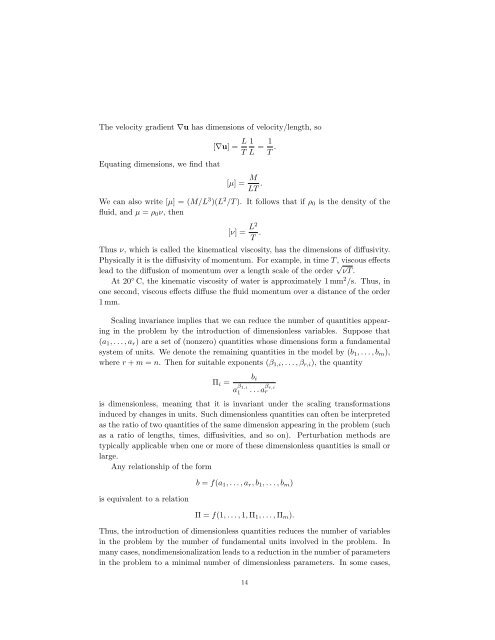Asymptotic Analysis and Singular Perturbation Theory
Asymptotic Analysis and Singular Perturbation Theory
Asymptotic Analysis and Singular Perturbation Theory
Create successful ePaper yourself
Turn your PDF publications into a flip-book with our unique Google optimized e-Paper software.
The velocity gradient ∇u has dimensions of velocity/length, so<br />
Equating dimensions, we find that<br />
[∇u] = L 1 1<br />
=<br />
T L T .<br />
[µ] = M<br />
LT .<br />
We can also write [µ] = (M/L 3 )(L 2 /T ). It follows that if ρ0 is the density of the<br />
fluid, <strong>and</strong> µ = ρ0ν, then<br />
[ν] = L2<br />
T .<br />
Thus ν, which is called the kinematical viscosity, has the dimensions of diffusivity.<br />
Physically it is the diffusivity of momentum. For example, in time T , viscous effects<br />
lead to the diffusion of momentum over a length scale of the order √ νT .<br />
At 20 ◦ C, the kinematic viscosity of water is approximately 1 mm 2 /s. Thus, in<br />
one second, viscous effects diffuse the fluid momentum over a distance of the order<br />
1 mm.<br />
Scaling invariance implies that we can reduce the number of quantities appearing<br />
in the problem by the introduction of dimensionless variables. Suppose that<br />
(a1, . . . , ar) are a set of (nonzero) quantities whose dimensions form a fundamental<br />
system of units. We denote the remaining quantities in the model by (b1, . . . , bm),<br />
where r + m = n. Then for suitable exponents (β1,i, . . . , βr,i), the quantity<br />
Πi =<br />
a β1,i<br />
1<br />
bi<br />
. . . a βr,i<br />
r<br />
is dimensionless, meaning that it is invariant under the scaling transformations<br />
induced by changes in units. Such dimensionless quantities can often be interpreted<br />
as the ratio of two quantities of the same dimension appearing in the problem (such<br />
as a ratio of lengths, times, diffusivities, <strong>and</strong> so on). <strong>Perturbation</strong> methods are<br />
typically applicable when one or more of these dimensionless quantities is small or<br />
large.<br />
Any relationship of the form<br />
is equivalent to a relation<br />
b = f(a1, . . . , ar, b1, . . . , bm)<br />
Π = f(1, . . . , 1, Π1, . . . , Πm).<br />
Thus, the introduction of dimensionless quantities reduces the number of variables<br />
in the problem by the number of fundamental units involved in the problem. In<br />
many cases, nondimensionalization leads to a reduction in the number of parameters<br />
in the problem to a minimal number of dimensionless parameters. In some cases,<br />
14
















